is about the ideas and technologies that will enable the affordable movement of people and goods from the surface of the Earth to orbit and beyond. It is about the ideas and technologies that will allow mankind to explore, develop, and colonize space.
 A manned mission to a near Earth asteroid
A manned mission to a near Earth asteroid
_______________________________________________________
1: Skyhooks and Space Elevators
refers to a group of three proposed space transportation concepts that their promoters claim will make Earth-to-orbit and interplanetary spaceflight affordable, thereby opening the way for the commercial development of lunar mining, asteroid mining, space-based solar power stations, space colonies, and colonies on the Moon, Mars, and in the asteroids.
These three concepts are:
1) A non-rotating Earth surface to geostationary orbit Space Elevator as described by Arthur C. Clarke in his book The Fountains of Paradise.
_______________________________________________________
2) A non-rotating Skyhook for Earth as first proposed by E. Sarmont in 1990. [1]
_____________________________________________________
3) A rotating Skyhook as first proposed by H. Moravec in 1977. [2]
_____________________________________________________
All three of these concepts have advantages and disadvantages. The most significant of them being:
- the rotating and non-rotating Skyhooks can be built with currently existing materials and technology while the Earth surface to geostationary orbit Space Elevator cannot,
- the rotating and non-rotating Skyhooks require a suborbital launch vehicle to get the lower end of the tether while the Earth surface to geostationary orbit Space Elevator does not,
- the rotating and non-rotating Skyhooks require either an electrodynamic or ion propulsion system for altitude control while the Earth surface to geostationary orbit Space Elevator does not.
Of these three items the most important to remember is that both the rotating and non-rotating Skyhooks can be built with existing materials and technology while the Earth surface to geostationary orbit Space Elevator cannot. [3][4][5][6][7][8][9]
The following is a direct quote from “Space Elevators, An Advanced Earth-Space Infrastructure for the New Millennium”, a NASA Conference Paper that discusses all three of these concepts. [3]
“The LEO space elevator [non-rotating Skyhook] is an intermediate version of the Earth surface to GEO space elevator concept, and appears to be feasible today using existing high-strength materials and space technology.”
___________________________________
The following is a direct quote from “Hypersonic Airplane Space Tether Orbital Launch System” (HASTOL), a NASA funded study on rotating Skyhooks. [4]
“The fundamental conclusion of the Phase I HASTOL study effort is that the concept is technically feasible. We have evaluated a number of alternate system configurations that will allow hypersonic air-breathing vehicle technologies to be combined with orbiting, spinning space tether technologies to provide a method of moving payloads from the surface of the Earth into Earth orbit. For more than one HASTOL architecture concept, we have developed a design solution using existing, or near-term technologies. We expect that a number of the other HASTOL architecture concepts will prove similarly technically feasible when subjected to detailed design studies. The systems are completely reusable and have the potential of drastically reducing the cost of Earth-to-orbit space access.”
____________________________________
The following is a quote from Keith Henson, co-founder of the L-5 Society regarding the Earth surface to geostationary orbit Space Elevator. [5]
“No current material exists with sufficiently high tensile strength and sufficiently low density out of which we could construct the cable. There’s nothing in sight that’s strong enough to do it – not even carbon nanotubes.”
____________________________________
While no Skyhook capable of capturing an arriving spacecraft has been built so far, there have been a number of flight experiments exploring various aspects of the Skyhook/space tether concept. [10]
_________________________________________________________
2: Affordable spaceflight and Skyhooks
The three most important issues that need to be addressed if a transportation system is to be commercially affordable on a mass-market level are:
- reusability,
- low propellant fraction,
- high payload fraction.
Reusability so the investment can be amortized over a large number of trips, a low propellant fraction for reduced operating costs, and a large payload fraction so that the cost of each trip can be distributed over a large amount of payload. Trains, planes, automobiles, trucks, and ships are all very good examples of this. Currently existing expendable rockets are not.
When a launch vehicle takes-off to go to Earth orbit, approximately 90% of its take-off weight is propellant, 9% is the weight of the rocket, and 1% is the weight of the payload.
Compared to trains, planes, automobiles, trucks, and ships, it should be fairly obvious why the currently existing expendable launch vehicles are somewhat of a failure when it comes to meeting the three main requirements for a commercially affordable mass-market transportation system.
The reasons for this failure are threefold:
- the speed the rocket needs to achieve to reach Earth orbit,
- the amount of propellant it takes to achieve that speed (which has to do with the performance of the rocket motor),
- the lack of reusability of the launch vehicle.
The total speed that a launch vehicle needs to achieve in order to reach low Earth orbit is approximately 9,400 m/s. This includes the speed of low Earth orbit, plus additional velocity for overcoming the force of gravity that is trying to pull the rocket down, and additional velocity for the atmospheric drag as the launch vehicle climbs through the atmosphere.
A Skyhook makes spaceflight affordable by reducing the speed the rocket needs to achieve in order to reach low Earth orbit. That reduction in speed means less propellant is required. The reduction in propellant allows the size of the payload to be increased. A larger payload and less propellant reduces the cost of getting to orbit.
In order to provide some order of magnitude examples of how different sized reductions in velocity translate into increased payload capacity, some simple calculations were made using the ideal rocket equation, the 90% propellant, 9% rocket, and 1% payload ratio, and the 9,400 m/s total speed for orbit value. The results of these calculations show that:
- reducing the speed required for orbit by 200 m/s increases the payload size by 50% and reduces the cost by 33%,
- reducing the speed required for orbit by 400 m/s doubles the size of the payload and reduces the cost by 50%,
- reducing the speed required for orbit by 800 m/s triples the size of the payload and reduces the cost by 67%,
- reducing the speed required for orbit by 1,600 m/s increases the payload by a factor of 6 and reduces the cost by 84%.
This process continues as the Skyhook gets longer and applies to both rotating and non-rotating Skyhooks.
Reusability of the launch vehicle is the third key issue that needs to be addressed if a Skyhook space transportation system is to become commercially affordable on a mass-market level. Using some of the increased payload capacity that the Skyhook makes possible to make the launch vehicle reusable is an idea that is used and discussed in every reference in this article that discusses either rotating or non-rotating Skyhooks. The specific amount of extra weight that will be required to make a launch vehicle reusable will depend on the details of the launch vehicle design. Is it single-stage-to-orbit, two-stage-to-orbit, ground launched, air launched, catapult launched, air-breathing, all rocket, or a combination propulsion system? All of these will have different requirements in order to make the launch vehicle reusable. But regardless of the details, using some of the increased payload capacity made possible by the Skyhook to go from an expendable launch vehicle to a reusable launch vehicle, will also be a very important step in the process of making spaceflight mass-market affordable: which is the whole purpose of a Skyhook.
________________________________________________________
3: Non-rotating Skyhooks
A non-rotating Skyhook is a vertically oriented, gravity gradient stabilized tether whose lower endpoint does not reach the surface of the planet it is orbiting. As a result the lower end of the cable appears to be hanging from the sky, hence the name skyhook. The idea of using a tidally stabilized tether for downward-looking Earth observation satellites was first proposed by the Italian scientist Giuseppe Colombo. [11]
The idea of using a non-rotating Skyhook as part of a space transportation system for Earth where sub-orbital launch vehicles would fly to the bottom end of the tether, and spacecraft bound for higher orbit, or returning from higher orbit, would use the upper end of the tether, was first proposed by E. Sarmont in 1990, expanded on in a second paper in 1994, and in a third paper in 2014. [1][12][13]
Other scientists and engineers, as well as NASA, Lockheed Martin, former astronaut Bruce McCandless II, and Dr. Robert Zubrin, have also investigated, validated, and added to this concept. [3][14][15][16][17][18][19][20][21][22]
In addition, NASA representatives who have reviewed this concept have described it as, “The first idea we have seen that offers a believable path to $100 per pound to orbit.” [23]
Conceptually the main difference between a non-rotating Skyhook and an Earth surface to geostationary orbit Space Elevator is that the non-rotating Skyhook does not reach down to the surface of the Earth. The lower end of the non-rotating Skyhook is above the upper edge of the atmosphere and requires a high-speed aircraft/sub-orbital launch vehicle to get there. Since the lower end of the Skyhook is moving at less than orbital velocity for its altitude, a launch vehicle flying there can carry a larger payload than it could carry to orbit on its own. When the cable is long enough, Single-Stage To Skyhook flight with a reusable sub-orbital launch vehicle becomes possible. In addition, unlike a Space Elevator that remains over the same spot on the Earth, a non-rotating Skyhook circles the planet every few hours. This allows the Skyhook to serve as a terminal for sub-orbital launch vehicles arriving from just about anywhere on Earth. This type of Skyhook can start out as short as 200 km and grow to over 4,000 km in length using a bootstrap method that takes advantage of the reduction in launch costs that come with each increase in tether length.
At its longest, a mature non-rotating Skyhook is approximately 1/25th the length of the 100,000 km long Space Elevator. As a result, it is much lighter in mass, and can be affordably built with existing commercially available carbon fiber materials. Analysis has also shown that this saving in construction cost for the non-rotating Skyhook more than makes up for the additional cost of the sub-orbital launch vehicle that it requires. As a result, a mature non-rotating Skyhook with reusable single stage sub-orbital launch vehicle is considered to be cost competitive with what is thought to be realistically achievable using a Space Elevator, assuming a Space Elevator can ever be built. [3][5][6][7][8][9][13]
A visual comparison of the various Space Elevator and non-rotating Skyhook concepts that have been proposed (the non-rotating Skyhook is referred to as a LEO Space Elevator in this drawing)
_____________________________________________
Another advantage of the non-rotating Skyhook is that once it is long enough, the upper end of the cable will be moving at just short of escape velocity for its altitude. This means that a spacecraft such as the Orion spacecraft could be placed on either a free-return orbit to the Moon, or on course for a near-Earth asteroid, without the need for an expensive expendable upper stage for boosting it to escape velocity. Elimination of the expendable upper stage and all the propellant it will require will also dramatically reduce the number of flights to the lower end of the non-rotating Skyhook, which will further reduce the cost of such a mission. [3][11][12][23]
This ability to capture sub-orbital launch vehicles coming up from the Earth at the lower end of the cable, and to launch spacecraft to higher orbits from the upper end of the cable, requires energy. Energy that comes from either a solar powered ion propulsion system or an electrodynamic propulsion system on the Skyhook. The advantage of this over current launch systems is the greatly improved operating efficiency and reduced cost of either of these propulsion systems compared to conventional expendable rockets.
While these high-efficiency, low-thrust propulsion systems cannot be used for a planetary surface to orbit launch system due to their low thrust, they are perfect for use on an orbiting Skyhook due to their ability to gradually store up energy by raising the orbital altitude of the Skyhook between arriving and departing flights. [12][24][25]
_________________________________________________
The Docking Maneuver
The process of docking an arriving spacecraft at the lower end of the non-rotating Skyhook starts with the Skyhook in an elliptical orbit. The low point of this elliptical orbit, the perigee, is selected so that the lower end of the Skyhook cable will be at an altitude of 185 km at that point in the orbit. The altitude of the high point of the elliptical orbit, the apogee, is selected based on the mass of the arriving spacecraft.
In addition to boosting the arriving spacecraft to the proper speed and altitude for rendezvous, the sub-orbital launch vehicle for this flight will also need to time its take-off so that the arriving spacecraft will rendezvous with the lower end of the Skyhook when the Skyhook is at the low point of its orbit.
When the arriving spacecraft docks with the lower end of the Skyhook it will lower the center of gravity of the total Skyhook system, thereby pulling the Skyhook down into a lower more circular orbit. If the apogee altitude of the Skyhook’s initial elliptical orbit was properly selected, the Skyhook will end up in a circular orbit after the arriving spacecraft has docked.
Upon completion of the docking maneuver, the Skyhook’s solar-powered ion propulsion system, or electrodynamic propulsion system, is activated so as to start raising the orbital altitude of the Skyhook back to its original altitude.
What makes the Skyhook concept work is energy exchange. When the Skyhook is in its initial elliptical orbit it is in a higher-energy orbit than the one it ends up in after the arriving spacecraft docks with the lower end of the Skyhook. What happens is that the Skyhook gives the extra energy of the higher elliptical orbit to the arriving sub-orbital spacecraft; a spacecraft that doesn’t have enough energy to remain in orbit on its own. The end result is that the arriving spacecraft gets an energy boost from the Skyhook that allows it to remain in orbit while the Skyhook gives up energy and drops to a lower energy orbit. Before another arriving spacecraft can dock at the lower end of the Skyhook, the Skyhook will need to use its high efficiency low thrust propulsion system to raise itself back to the original higher-energy orbit.
______________________________________________
4: An Initial Non-rotating Skyhook
Assume a 200 km long 5,600 kg tether with a 2,000 kg docking crane at each end, a 100,000 kg space station, and a 40,000 kg ion propulsion/power system designed for a flight rate of 12 flights per year. The baseline orbit for this basic start-up Skyhook is an elliptical orbit that has a low point altitude of 350.6 km and a high point altitude of 445.3 km. As with all Skyhooks, it is the center of gravity of the system that is in orbit. Since the speed required for orbit decreases with altitude, those parts of the Skyhook that are below the center of gravity are moving at less than orbital velocity for their altitude and want to move closer to the Earth, while those parts that are above the center of gravity are moving faster than orbital velocity for their altitude and therefore want to move further away from the Earth. The end result is a vertically oriented tether that is under constant tension. Due to this tension, the tether/space station combination acts like a long thin tower with a weight that can be positioned anywhere along its length and the center of gravity of the system is determined by the vertical location of the space station on the tether.
Note: the mass for the tether used in this example was calculated using the fiber properties for the T1000GB carbon fiber as shown on the TORAY Industries website, a thermoplastic matrix, a 65% fiber volume, a safety factor of 5 to 1, and an arriving spacecraft mass of 14,800 kg.
Preparing for an Arriving Spacecraft In order to prepare the Skyhook for docking with a spacecraft that is coming up from the Earth, the space station will need to be positioned 170.3 km up from the bottom end of the tether. This will put the center of gravity of the Skyhook at the 165.6 km mark. This means that when the Skyhook system is at the low point of its baseline orbit, the bottom end of the tether will be 185 km above the surface of the Earth moving at 96.67% of circular orbit velocity for that altitude.
The Launch System The launch system used for this example is a launch vehicle and spacecraft similar in size and performance to the Falcon 9 launch vehicle and Dragon spacecraft. This particular launch vehicle and spacecraft combination has the ability of delivering a 6,000 kg useful payload to a 185 km high circular due east orbit. The calculated useful payload for this system when flying to a 335 km high circular due east orbit is 5514 kg. The calculated useful payload for this system when flying to the bottom of this Skyhook is 7,736 kg. That represents a 40% increase in useful payload when flying to the Skyhook compared to flying directly to a space station in a 335 km high orbit that does not have a Skyhook. Assuming the same cost per flight both with and without the Skyhook, this basic Skyhook will reduce the launch cost of this launch system by 29% compared to flying direct to a space station without a Skyhook. This reduction in launch cost will continue to improve as the length of the Skyhook increases.
Hooking Up When an arriving spacecraft docks with the bottom of the Skyhook it lowers the center of gravity of the system. If the arriving spacecraft has a mass of 14,800 kg, it would lower the center of gravity of the Skyhook by 15.6 km: from 165.6 km above the bottom of the tether down to 150 km. This also changes the orbit of the Skyhook from the initial 350.6 x 445.3 km high elliptical orbit to a 335 km high circular orbit.
Bringing the Spacecraft and Space Station Together Once the arriving spacecraft is firmly attached to the bottom end of the tether, the space station starts pulling the tether up. At the same time this also pulls the space station down closer to the Earth. The end result is that the center of gravity of the Skyhook stays in the same 335 km high circular orbit while the space station and spacecraft gradually come together and dock.
The Orbit Raising Maneuver While the space station is gradually moving down the tether towards the spacecraft, the Skyhook’s ion propulsion system is activated in order to start raising the orbital altitude of the Skyhook. Once the arriving spacecraft has docked with the space station and the crew change has occurred, the spacecraft is lowered ~45 km down from the space station. Since the departing spacecraft is moving at less than orbital velocity while hanging on the tether at this altitude, no retro rocket burn is required for the return to Earth, and the release of the spacecraft will need to occur when the Skyhook is in the proper position over the Earth for the departing spacecraft to arrive at its planned landing site. Prior to the release of the departing spacecraft, the docking crane at the lower end of the Skyhook will be used to salvage the spacecraft’s solar array/trunk module in order to add it to the Skyhook’s power system. This solar array is normally discarded and allowed to burn up in the atmosphere when the spacecraft is departing from a space station that is not equipped with a Skyhook. After the departing spacecraft has gone, the ion propulsion system will continue thrusting until the Skyhook is back in its baseline 350.6 x 445.3 km elliptical orbit in time for the next arriving spacecraft. The ion propulsion system will consume a total of 86.7 kg of propellant for this orbit raising maneuver.
_______________________________________________________
5: The Upper End of a Mature Non-rotating Skyhook
 Earth-Moon Transfer via a Non-rotating Skyhook
Earth-Moon Transfer via a Non-rotating Skyhook
The upper end of a mature non-rotating Skyhook is designed to be moving at slightly less than escape velocity for its altitude. What this means is that a spacecraft departing from the upper end of the Skyhook can, with the use of only a very small amount of onboard propellant, be headed for geosynchronous orbit, on a free return trajectory to the Moon, on its way to one of the Lagrange Points, or headed for a Near Earth Asteroid.
To put this in perspective, consider the Saturn V rocket that was used to fly to the Moon in the late ’60s and early ’70s. The Saturn V had a take-off weight of 6,200,000 pounds. Its payload to low Earth orbit was 260,000 pounds. Its useful payload to Earth escape velocity was 100,000 pounds. Everything else, 6,100,000 pounds worth, was used up and thrown away. Now compare this to a mature non-rotating Skyhook launch system.
A passenger leaves Earth on a highly reusable suborbital spaceplane that takes off from an airport and flies to the bottom end of the non-rotating Skyhook. The passenger transfers from the spaceplane to the Skyhook and the spaceplane returns to Earth with a load of returning passengers and cargo.
The next step in the journey is a ride on the elevator up the tether to the space station in the middle of the Skyhook where a transfer is made to another elevator that is bound for the upper endpoint. Nothing is thrown away everything is reusable.
At the upper endpoint station the passenger transfers to a small reusable Earth-Moon spacecraft that is similar to the Apollo Command/Service Module, which will take him/her to lunar orbit. The Earth-Moon spacecraft will use a very small amount of onboard rocket propellant when it departs the upper end of the Skyhook, and will then fire its rocket motor a second time to slow down to lunar orbit velocity when it arrives at the Moon.
Upon arrival in lunar orbit, the Earth-Moon spacecraft will rendezvous and dock with a reusable single stage Lunar Lander that is carrying passengers and cargo bound for Earth plus additional rocket propellant for the Earth-Moon spacecraft. After the passenger, cargo, and propellant exchange is complete, the Lunar Lander leaves lunar orbit and descends to the surface of the Moon.
Again, everything is reusable, nothing is thrown away, and the rocket propellant for the Lunar Lander and the Earth-Moon spacecraft comes from the Moon.
______________________________________________________
6: The Earth-Moon Spacecraft
 Orion spacecraft
Orion spacecraft
NASA is currently funding the development of a reusable Earth-Moon/Earth-Asteroid spacecraft that is similar to an Apollo Command/Service Module called the Orion spacecraft. Operate this spacecraft from the upper end of a non-rotating Skyhook and we will have an affordable transportation system for traveling to lunar orbit, the Earth/Moon Lagrange points, and the near Earth asteroids. Add a single stage reusable Lunar Lander and we will have an affordable transportation system for going to the lunar surface. With access to Lunar and/or near Earth asteroid materials, the building of a large, well shielded, rotating, Mars cycler spacecraft becomes possible, and safe regular affordable interplanetary spaceflight to Mars, the Moons of Mars, as well as Ceres and all the other asteroids between Mars and Jupiter, becomes possible.
_______________________________________________________
7: A Non-rotating Skyhook Transportation System for Mars

In 1984, Paul Penzo of JPL proposed a planetary surface to escape velocity tether transportation system for Mars that consists of two unpowered non-rotating Skyhooks; one attached to the Martian moon Phobos, and the other attached to the Martian moon Deimos.
With this system, a spacecraft arriving at Mars, either direct from Earth, from an outpost space station, or from an Earth-Mars cycler spacecraft as it swings by Mars, docks at the upper end of the non-rotating Skyhook attached to the outer moon Deimos. The people and cargo on that spacecraft then transfer to an elevator on the Skyhook that will take them down to the lower end of the Deimos Skyhook. There they board a small orbital transfer vehicle that will take them to the upper end of the non-rotating Skyhook that is attached to the inner moon Phobos. Again they transfer to an elevator that will take them to the lower end of the Phobos Skyhook where they will transfer to the reusable single stage Mars Lander that will carry them to the Martian surface. Passengers and cargo from the Martian surface that are bound for either the asteroids, or for Earth, would ride the system in reverse.
One of the advantages of this concept is that neither Skyhook will require a propulsion system for orbital re-boost or for orbit control, as they both will use the Martian moon they are attached to as a momentum bank to make up any differences in the upward versus downward mass flow of people and cargo. This elimination of the propulsion systems for the two Skyhooks also makes for a significant reduction in the cost to build, and the cost to operate. Like the non-rotating Skyhook for Earth, this two-stage non-rotating Skyhook system for Mars can be affordably built with existing materials and technology. [26][27]
_____________________________________________________
References
1) Sarmont, E. (26 May 1990). An Orbiting Skyhook: Affordable Access to Space. International Space Development Conference (Anaheim California).
2) Moravec, H (1978). “Non-Synchronous Orbital Skyhooks for the Moon and Mars with Conventional Materials”. Archived from the original on 1999-02-03.
3) Smitherman, D.V. “Space Elevators, An Advanced Earth-Space Infrastructure for the New Millennium”. NASA/CP-2000-210429. Archived from the original on 2007-02-21.
http://www.nss.org/resources/library/spaceelevator/2000-SpaceElevator-NASA-CP210429.pdf
4) Bogar, Thomas J.; Bangham, Michal E.; Forward, Robert L.; Lewis, Mark J. (7 January 2000). “Hypersonic Airplane Space Tether Orbital Launch System”. Research Grant No. 07600-018l Phase I Final Report (PDF). NASA Institute for Advanced Concepts. Archived (PDF) from the original on 2005-12-18. Retrieved 2014-03-20.
5) Dvorsky, G. (13 February 2013). “Why we’ll probably never build a space elevator”. com.
http://io9.com/5984371/why-well-probably-never-build-a-space-elevator
6) Feltman, R. (7 March 2013). “Why Don’t We Have Space Elevators?”. Popular Mechanics.
http://www.popularmechanics.com/space/a8814/why-dont-we-have-space-elevators-15185070/
7) Scharr, Jillian (29 May 2013). “Space Elevators On Hold At Least Until Stronger Materials Are Available, Experts Say”. Huffington Post.
http://www.huffingtonpost.com/2013/05/29/space-elevators-stronger-materials_n_3353697.html
8) Templeton, Graham (6 March 2014). “60,000 miles up: Space elevator could be built by 2035, says new study”. Extreme Tech. Retrieved 2014-04-19.
9) Darnell (10 April 2009). “Are Traditional Space Elevators the Wrong Way Up?”. Colony Worlds. Archived from the original on 2009-07-14.
http://colonyworlds.com/2009/04/are-traditional-space-elevators-the-wrong-way-up.html
10) Chen, Yi; Huang, Rui; Ren, Xianlin; He, Liping; He, Ye (2013). “History of the Tether Concept and Tether Missions: A Review”. ISRN Astronomy and Astrophysics 2013. doi:1155/2013/502973. Retrieved 2014-03-07.
http://www.hindawi.com/journals/isrn/2013/502973/
11) Cosmo, M.; Lorenzini, E. (December 1997). Tethers in Space Handbook (PDF) (Third ed.). Smithsonian Astrophysical Observatory. Archived (PDF) from the original on 2003-03-22.
http://www.tethers.com/papers/tethersinspace.pdf
12) Sarmont, E. (October 1994). “How an Earth Orbiting Tether Makes Possible an Affordable Earth-Moon Space Transportation System”. SAE 942120.
13) Sarmont, E. (July 2014). “Affordable Access to Space: Basic Non-Rotating Skyhook with Falcon 9 & Dragon” (PDF).
https://www.dropbox.com/s/fp6q6eq9iky8vwo/Affordable%20Access%20to%20Space%2C%201.pdf
14) Wilson, N. (August 1998). “Space Elevators, Space Hotels and Space Tourism”. SpaceFuture.com.
http://www.spacefuture.com/archive/space_elevators_space_hotels_and_space_tourism.shtml
15) Mottinger, T; Marshall, L. “The Bridge to Space – A space access architecture”. AIAA 2000-5138.
http://arc.aiaa.org/doi/abs/10.2514/6.2000-5138
16) Mottinger, T; Marshall, L (2001). “The Bridge to Space Launch System”. Space Technology and Applications International Forum. CP552.
17) Marshall, L; Ladner, D; McCandless, B (2002). “The Bridge to Space: Elevator Sizing & Performance Analysis”. Space Technology and Applications International Forum. CP608.
18) Stasko, S; Flandro, G. “The Feasibility of an Earth Orbiting Tether Propulsion System”. AIAA 2004-3901.
http://arc.aiaa.org/doi/abs/10.2514/6.2004-3901
19) Zubrin, R (September 1993). “The Hypersonic Skyhook”. Analog Science Fiction / Science Fact 113 (11): 60–70.
20) Zubrin, R (March 1995). “The Hypersonic Skyhook”. Journal of the British Interplanetary Society 48 (3): 123–128. Bibcode:..48..123Z.
http://adsabs.harvard.edu/abs/1995JBIS…48..123Z
21) Andrews, D. (3 September 2009). “Advanced ETO Space Transportation”. NASA Langley Advanced Space Transportation Workshop. Archived from the original on 2014-07-13.
22) Andrews, D. “Space Colonization: A Study of Supply and Demand” (PDF). Archived (PDF) from the original on 2012-03-11.
http://web.archive.org/web/20120311204915/http://www.spacearchitect.org/pubs/IAC-11-E5.1.8.pdf
23) Sarmont, E. “Affordable to the Individual Spaceflight”. Archived from the original on 2007-02-13.
http://web.archive.org/web/20070213093349/http://www.affordablespaceflight.com/home.html
24) “The Incredible Ions of Space Propulsion”. Science at NASA. NASA. 16 June 2000. Archived from the original on 2011-10-23.
25) Sovey, J.S.; Rawlin, V.K.; Patterson, M.J. (May–June 2001). “Ion Propulsion Development Projects in U.S.: Space Electric Rocket Test 1 to Deep Space 1”. Journal of Propulsion and Power 17 (3): 517–526.
https://archive.org/stream/nasa_techdoc_20010093217/20010093217#page/n0/mode/2up
26) Penzo, P. (July 1984). Tethers for Mars Space Operations. The Case for Mars II. 62 Science and Technology Series. pp. 445–465.
27) Orion spacecraPenzo, P; Carroll, J (December 1997). Mars Moons Tether Transport System (PDF). Tethers in Space Handbook (3rd ed.). pp. 70–71. Archived (PDF) from the original on 2003-03-22.
http://web.archive.org/web/20030322134829/http://www.tethers.com/papers/TethersInSpace.pdf
Index of Additional Articles
- Opening the High Frontier
- Skyhook, a Journey to Orbit and Beyond
- In the Beginning . . .
- Why do Rockets Cost so Much?
- Combination Launch Systems
- It’s All About Speed!
- Visions of the Future
- The Call of an Unlimited Future
- Combination Launch Systems, part 2
- Outward Bound: Beyond Low Earth Orbit
- and someday . . . Starships!
- Mars: how to get there
- Outpost Space Stations
- Dreams of Space
- The Moon or Mars?
- Skyhooks and Space Elevators
- Stratolaunch and the X-15
- Starship Congress
- Making Spaceflight Affordable
- How a Combination Launch System Works
- Starship Conference 2017
- New Worlds Conference 2017
- Opening the High Frontier
- Building a Spacefaring Civilization
- Space Exploration and the Future
Other websites
- Skyhooks, Space Elevators and Space Exploration
- Vertical Accelerator Launch Tower
- Combination launch system
- Opening the High Frontier (the Book)
Videos
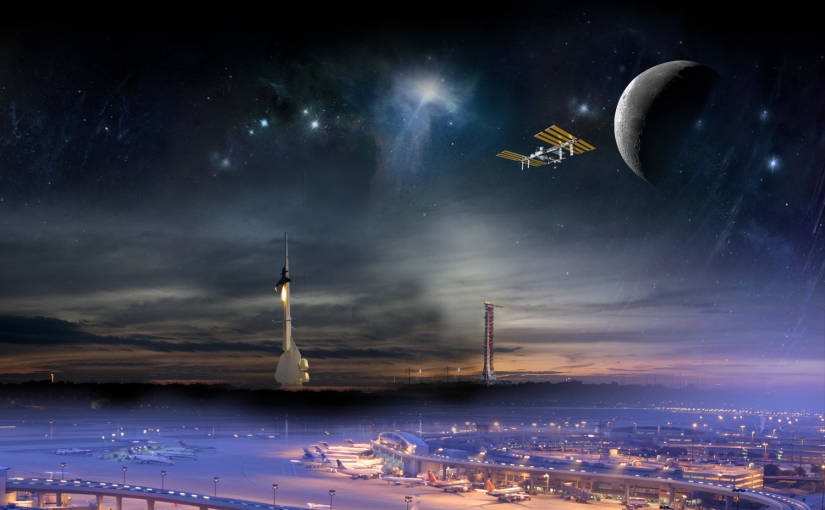
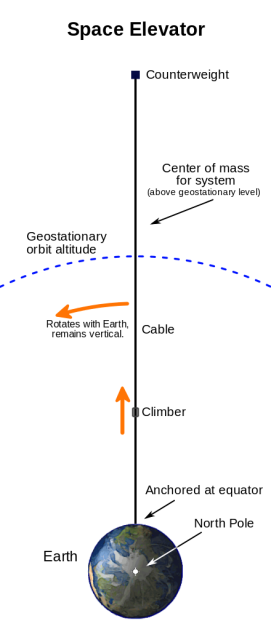
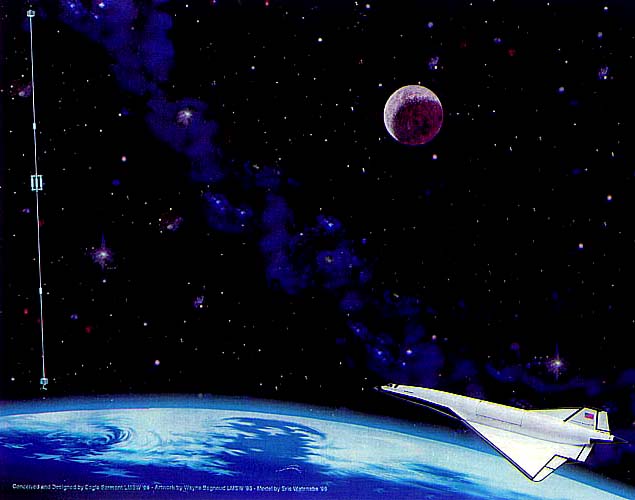
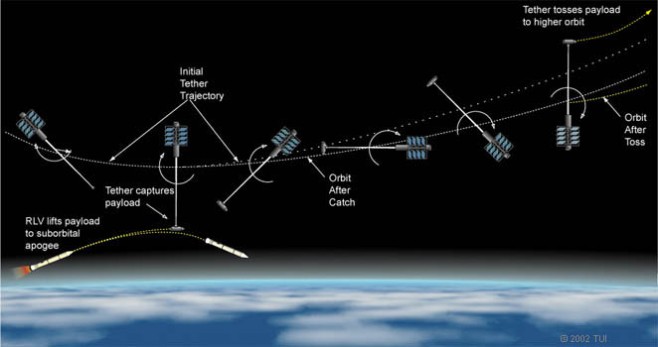

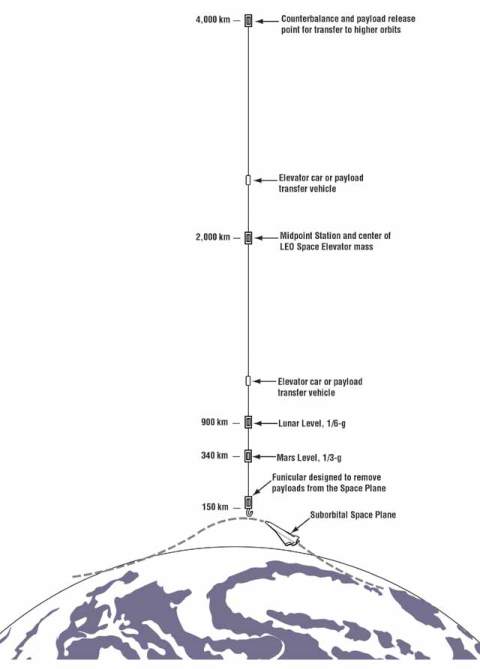
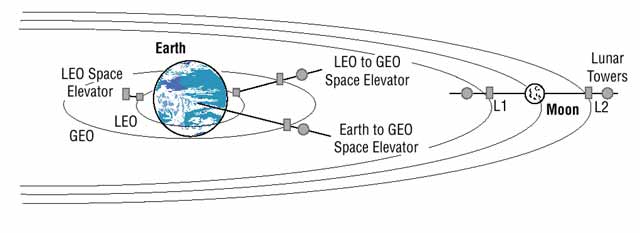
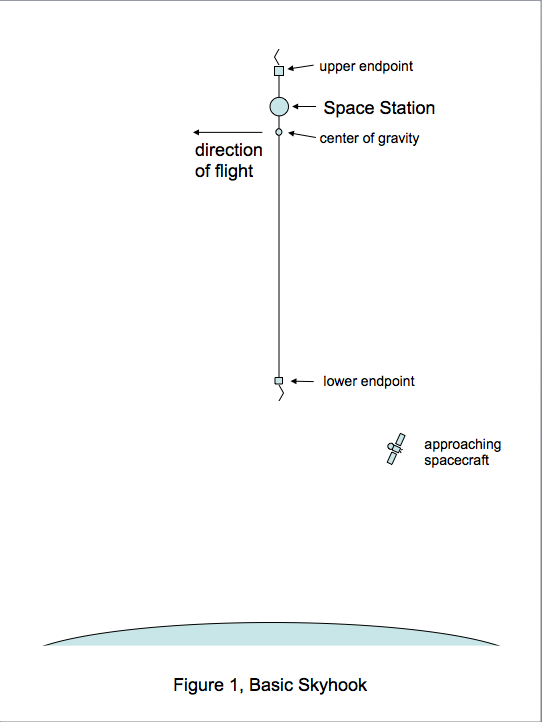
I enjoyed this page. Hope you do more sky hook stuff.
LikeLike
I’m an engineer/physicist and I approve of this post!
LikeLike
Very interesting. Quite surprising this hasn’t been much on the news, given how promising this seems.
Are we in position to overcome the challenges? (attaching to the tether, maintenance of cable through debris collisions, atmospheric friction etc)
LikeLike
Thank you for your interest, and yes, the challenges are manageable. Every time the central space station moves up and down the cable it will inspect all the strands that make up the cable. Each strand is identical and designed to be replaced without interfering with the operation of the skyhook. Atmospheric friction is overcome by the onboard ion propulsion system that is also used for controlling orbital altitude.
LikeLiked by 1 person